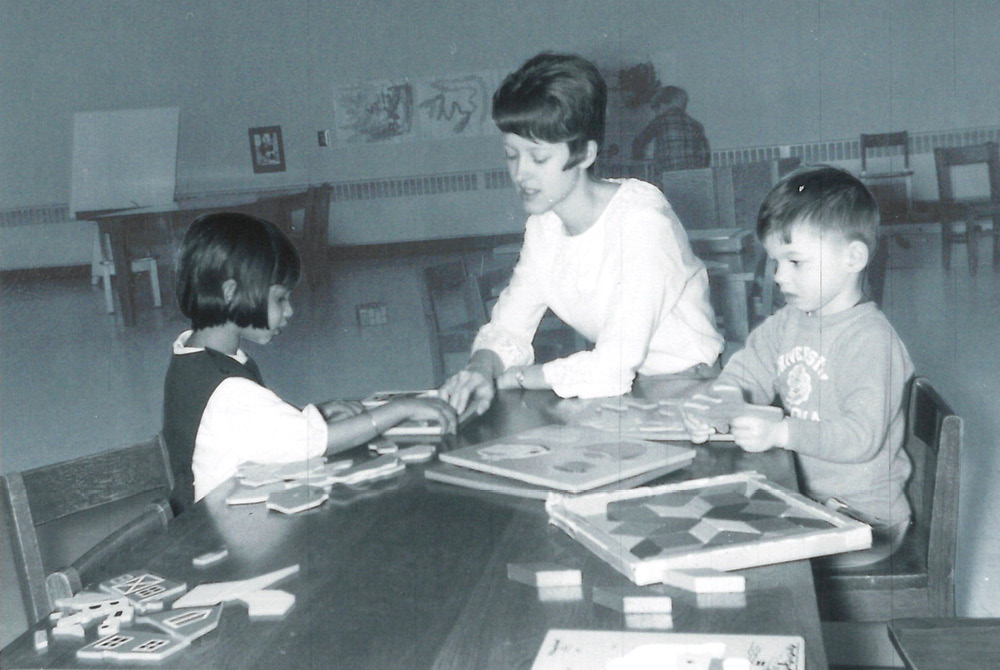The low participation of men in early education is a topic that fascinates me, and I decided to write this article as a challenge to myself. The research on men in early education is limited; most of it is antiquated (Wilson, 2011). Johnson (2010) maintains that more than 30 percent of elementary and secondary public school teachers were male as early as 1869. However, only 29 percent of teachers were men by the turn of the 20th century. The researchers specified that this number has decreased by 20 percent more than 50 years later.
Over the course of 26 years I have had the privilege of working with and meeting several amazing men dedicated to the early childhood profession. Yet there are too few. In my early childhood coursework I recall one or two males. More than two decades ago, the first early childhood center I worked at employed only one man. He was the janitor, and everyone’s favorite. The children and staff adored him. We called him “Mitchy,” and he kept a little space in the back of the center. Mitchy had a huge heart for the children, teachers and administrators in our center. He set up a work station in his back-of-the-center nook, but he would let us in whenever we felt the need to arrive unannounced and encroach upon his space. He had such a powerful influence on the environment. He was all things to all people, a good listener, a good driver, Mr. Fix-It, wise and patient.
I never questioned if he had an interest in becoming a teacher.
Peeters (2007) highlights the complexity and the shortage of males in child care in Europe. The European Commission Network on child care sought to increase the number of males in child care settings by 20 percent. They failed to meet their goal. Cunningham and Dorsey (2004) assert that when men are scarce or absent in the daily lives of children, children develop their understanding of masculine behavior from media portrayals, which often present men as violent and angry. They go on to state that television seldom captures males in a nurturing, caretaking and affectionate role. Men are rarely cast as the primary caretakers of children or responsible for managing the home (Cunningham & Dorsey, 2004). In early childhood settings, men serve as role models, father figures and big brothers. This provides a different perspective and invigorates the early childhood community (Wilson, 2011). There have been national efforts to recruit more male teachers, yet the field continues to struggle to gain a significant number of males in child care (Martino & Kehler, 2006; Mills, 2004; Mills, Martino, & Lingard, 2004).
The research of Davidson and Nelson (2011) and Tyack and Hansot (1982) indicates men played an integral role in teaching for many years. From the 1700s through the mid-1800s, teachers were primarily men (Davidson & Nelson, 2011; Tyack & Hansot, 1982). As gender expectations changed historically, the presence of men in teaching shifted over time. At one point, in both the United States and Ireland, men were forbidden to teach younger children. There was an assumption, the researchers argued, that women had a stronger moral character than men. Somehow men were presumed to have a negative influence on young children (Ni Bhroimeil, 2006; Perlman & Margo, 2001). Their research further posits that males are atypical in early childhood settings. Men are 5 percent of the child care workforce and 2 percent of preschool and kindergarten teachers (Holm, Janairo, Jordan & Wright, 2008).
According to Davidson and Nelson (2011), the experiences of men entering the teaching profession as a gender minority demonstrates the difficulties male teachers face when negotiating gendered expectations with their personal aspirations as teachers. In my subsequent positions, there were one or two male teachers scattered amongst us women. There were always whispers and skepticism. This saddened me. Not because of the lack of gender equity in the classroom. It was the fact that as teachers, we were unwilling to openly discuss and un-package the stereotypes and myths related to men in child care. I often wondered if these individuals grew tired of being “the only one.” I questioned if they knew they were viewed suspiciously by parents and teachers. I also wondered if they had grown tired of being questioned the most, or tired of being questioned about their qualifications, their desire to work with young children and if they change diapers. Did they question why the directors conveniently assigned them to work with the older groups or after school children? Or did they question why they were always asked to change the light bulbs, pick up boxes, unclog the toilet, climb on shelves and serve as the primary disciplinarian in the classroom?
To be quite honest, I was not courageous enough to challenge those directors or to ask my male colleagues what motivated them to remain in the profession. Yet, I quietly vowed to do differently if given an opportunity. Today, in my role as an educator and early childhood administrator, I recommend educators take several steps to help bring more men into our field and support them once they arrive.
ADVERTISEMENT
Taking a Proactive Approach

Our program strives to convey the importance of interacting with positive male role models. [©BMCC Early Childhood Center]
Second, meet with parents consistently to address concerns as they arise. More importantly, develop a zero tolerance for gender bias and stereotypical ideology or practices—if a parent displays skepticism or resistance to their child being placed in a classroom where a man is assigned, meet with the parent(s) until the issue is resolved. At the forefront of my conversations with parents is civility and respect. Yet, our organization is responsible for policy, recruitment, developing a culture of care, establishing equity in the workplace and hiring qualified individuals. I would not advise changing any child’s classroom due to gender concerns. As educators, we must be committed to maintaining productive dialogue with parents during any philosophical challenge. In my experience the concerns typically center on parents’ implicit biases. I implore them to give the classroom a chance and remain open to the conversation. This has consistently worked.
Third, create an environment that supports every individual’s equal and active voice within the early childhood setting. Every adult in the classroom should have a voice in program planning and coordinating classroom activities. This will ensure not only that males, but the entire teaching team, experience an equitable work environment and are invited to play an integral role in the classroom. We do not need hierarchy in the classroom, just equality.
The Borough of Manhattan Community College Early Childhood Center has promoted the importance of men in early care and education since its inception in 1984. The program’s model has helped set the tone for the field. This has been demonstrated by the employment of men throughout the program’s 35-year history. The center understands that children need to interface with role models of all ages, genders and belief systems. We also understand the importance of being a reflection of the diverse families that we serve. The center works to reflect this in our daily practices and through hiring early childhood practitioners. Amongst the center’s families, there are many single parent homes. Our program thus strives to convey the importance of interacting with positive male role models. Men take on various roles within the early childhood classroom: (1) they help us build community; (2) they serve as role models for young children and, (3) they demystify the role of men in early care and education.
I currently employ six men in different capacities. The first is a master’s-level early childhood educator and an artist, and he has been able to bring his eclectic teaching style and fine arts background into the classroom. The parents and team greatly support and love him. The second is our bookkeeper. He has an appreciation for campus child care because his daughter attended a campus center while he studied for his accounting degree. The third is a teacher’s assistant who originally joined us as part of the federal work study program. He is currently studying to enter the field as a physical education teacher. The fourth is a student working alongside senior management while he pursues a degree in social work and finance. He aspires to own his own children’s center.
The center also hires teaching artists, two who have been with our program for many years. Additionally we bring in two to three additional male students as federal work study employees. Through this endeavor we actively seek to balance the diverse needs of children. Federal work study employment affords students an opportunity to earn money while continuing their studies. This model has provided an opportunity for each of these talented individuals to develop genuine camaraderie as a group.
Recruitment of Pre-Service Teachers
The City University of New York has designed a program entitled “Men Teach.” Men teach recruits men of color for the profession. The program provides mentorship, networking and professional development opportunities. These efforts support culturally responsive practices in the classroom (Zhang, 2017; BMCC, 2016). Borough of Manhattan Community College is dedicated to conducting critical research to highlight the significance of males in the early childhood setting. In partnership with the New York City Department of Education and the Professional Development Institute (a workforce development agency that develops high quality professional development training and leadership initiatives for pre-service teachers, teachers and directors) BMCC has received a substantial grant to increase its efforts to support the recruitment of males in the early childhood work force. Using their research, the faculty and the Men’s Teach initiative on campus have conducted focus groups to support the active recruitment of men as early childhood educators.
Fellow Teachers
Teachers can support other males in child care by encouraging existing male teachers to mentor their colleagues. This is essential to an incoming teacher’s success. In order to continue to discuss the needs of children and families, teachers can support other males by developing focus groups throughout the year. Discussions should include developing a culturally diverse work force (BMCC, 2016) and promoting diverse teacher education forums. This year, BMCC’s teacher education day (a professional development day for preservice teachers) provided an opportunity for students to meet professionals in the field. Its career trajectory panel included: (1) a man of color as the keynote speaker and (2) three male panelists (out of 5). The round table discussions were led by males in early childhood (Teacher Education Day, 2019). This representation was important and powerful.
Our Field as a Whole
There are a number of steps we should take as a field to encourage increased participation by men in ECE. We should utilize empirically-based research to obtain grant funding to develop additional initiatives to promote males in early childhood settings. The Foundation for Child Development (2016) supported BMCC’s groundbreaking research and helped to raise the profile of males in the classroom through mentorship, focus groups and hands-on support (Whitebook, Mclean, Austin & Edwards, 2018).
As individuals and programs we can also enlist our local, state and federal government and higher education officials to continue to raise the profile of males in child care. By doing so, we continue to convey the importance of gender equity within our classrooms. Additionally a fair and equitable wage is a catalyst for growing the field (Zhang, 2017).
Finally, the value and significance of males in the early childhood classroom has been long been understated. It is important as educators for us to create a culture of inclusion that supports diverse perspectives in the classroom, as well as the workplace (Piburn, Nelson & Carson, 2011).
References
Borough of Manhattan Community College (BMCC) News. (2013, October 18). A Helping Hand for Student Parents. bmcc.cuny.edu
Borough of Manhattan Community College (BMCC) News. (2016, April 27). BMCC Receives $285,000 to Research Recruitment of Male Educators in Pre-K Classrooms. bmcc.cuny.edu
Cunningham, B., & Dorsey, B. (2004). Out of site but not out of mind: The harmful absence of men. Child Care Information Exchange, 42-43.
Davidson, K.G., & Nelson, B.G. (2011). Men and teaching: Good intentions and productive tensions. The Journal of Men’s Studies, 19(2), 91-96.
Foundation for Child Development. (n. d.). 2015-2016 Grants – Foundation for Child Development. New York City Early Childhood Research Network. fcd-us.org
Holm, J., Janairo, R., Jordan, T., & Wright, N. (2008). Where are the men? Promoting gender diversity in the Massachusetts early childhood workforce. The CAYL Schott Fellowship in Early Care and Education, 1-4.
Johnson, S.P. (2010). Still So Few Male Teachers: Now What?. YC Young Children, 65(3), 18.
Martino, W., & Kehler, M. (2006). Male teachers and the “boy problem”: An issue of recuperative masculinity politics. McGill Journal of Education/Revue des sciences de l’éducation de McGill, 41(2).
Mills, M. (2004). Male teachers, homophobia, misogyny and teacher education. Teaching Education, 15(1), 27-39.
Mills, M., Martino, W., & Lingard, B. (2004). Attracting, recruiting and retaining male teachers: Policy issues in the male teacher debate. British Journal of Sociology of Education, 25(3), 355-369.
Ní Bhroiméil, Ú. (2006). ‘Sending gossoons to be made oul’mollies of’: Rule 127 (b) and the feminisation of teaching in Ireland.
Peeters, J. (2007). Including men in early childhood education: Insights from the European experience. New Zealand Research in Early Childhood Education, 10, 15.
Perlman, J., & Margot, R.A. (2001). Women’s work? American school teachers 1650-1920. Chicago: University of Chicago Press
Piburn, D.E., Nelson, B.G., & Carlson, F.M. (2011). Men in teaching: Gender equality through the promise of gender balance. YC Young Children, 66(5), 64.
Plaisir, J. (2016) Borough of Manhattan Community College. Interview
Thompson, Alvarado-Santos, Fenton, Patrice. (2016). The Importance of Diversity: Recruiting Men of Color into the Teacher Pipeline. Office of Academic Affairs the City University of New York.
Teacher Education Day. (2019).
Tyack, D.B., & Hansot, E. (1982). Managers of virtue: Public school leadership in America, 1820-1980 (p. 183). New York: Basic Books.
Whitebook, M., McLean, C., Austin, L. J., & Edwards, B. (2018). Early Childhood Workforce Index 2018. Center for the Study of Child Care Employment, University of California at Berkeley.
Wilson, W.J. (2011). When work disappears: The world of the new urban poor. Vintage.
Zhang, W. (2017). Male teachers in early childhood education: Why more men? A review of the literature.
Zell, M. (2011). I Am My Brother’s Keeper: The Impact of a Brother2Brother Program on African American Men in College. Journal of African American Males in Education, 2(2).
Cecilia Scott-Croff, Ed.D, serves as the executive director of the Early Childhood Center at Borough of Manhattan Community College. A graduate of BMCC, she is also an adjunct faculty member with the teacher education department. Her work focuses on meeting the diverse needs of parents, children and teachers from an equity lens.
Related
ADVERTISEMENT











